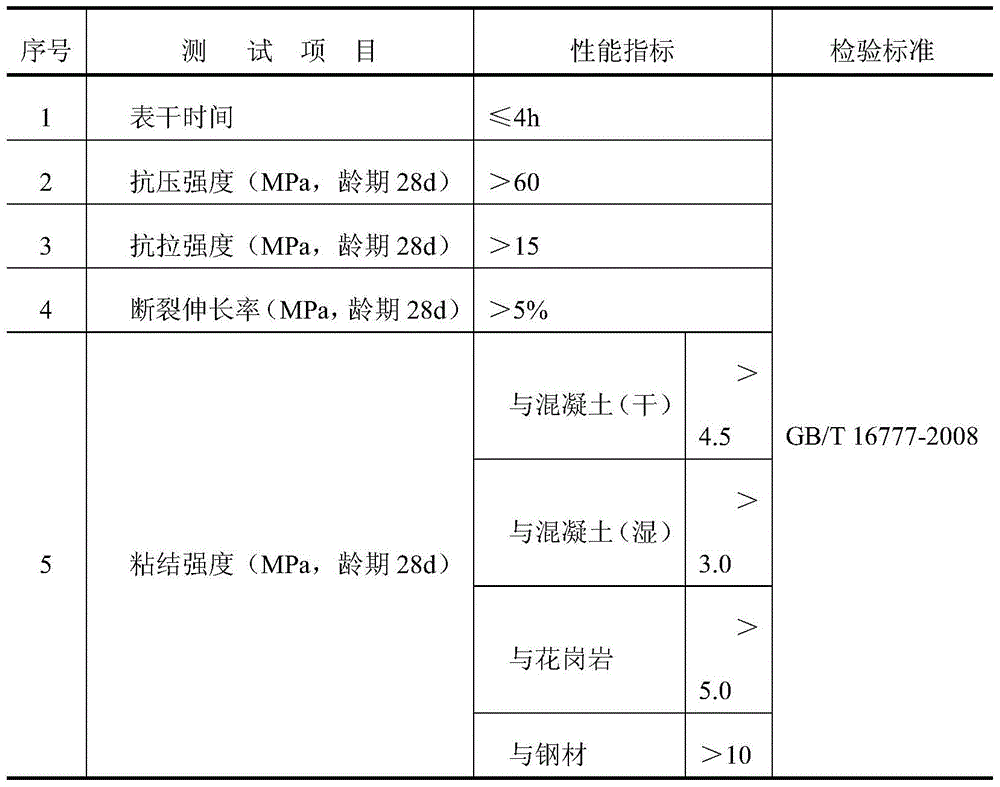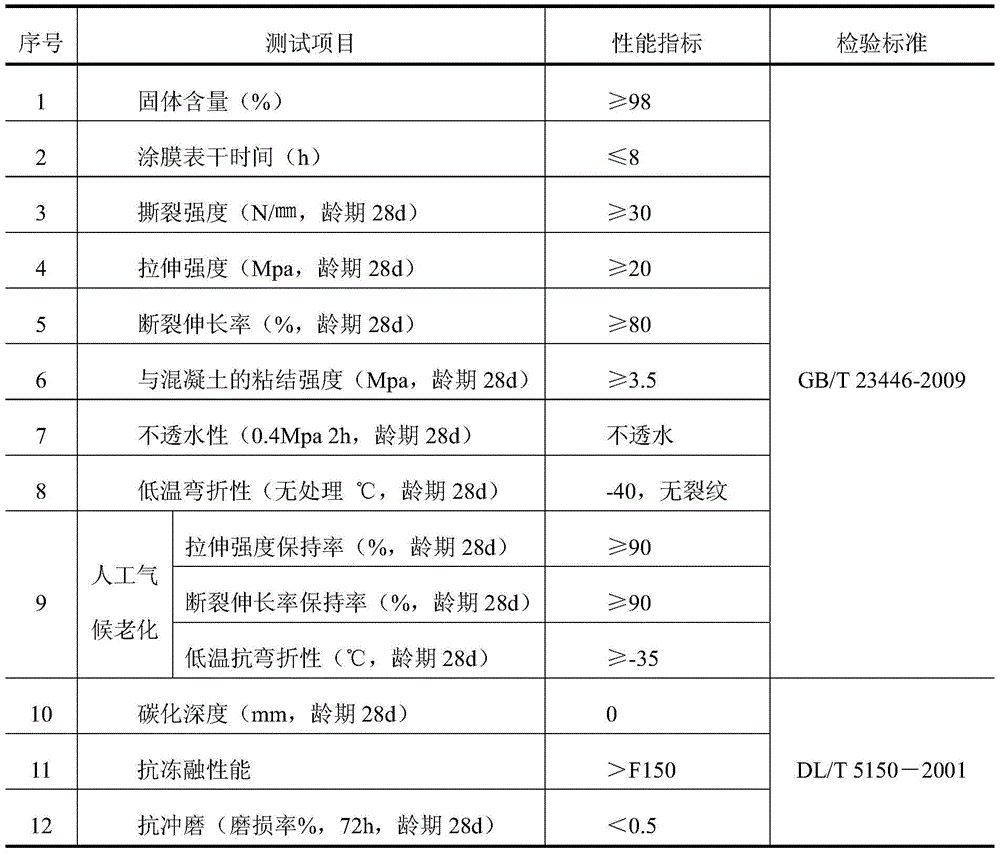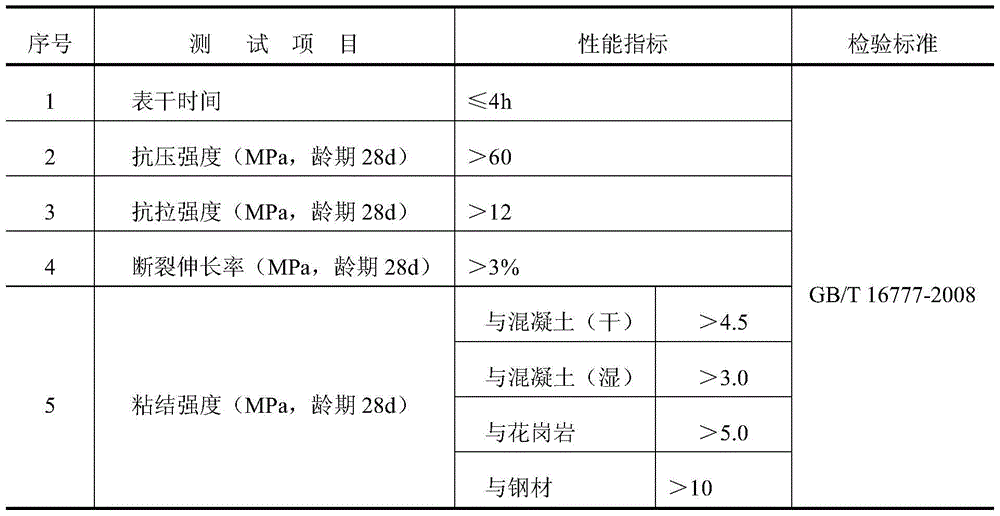Polyurea-polysiloxane organic-inorganic hybrid concrete biological pollution protection material and preparation method thereof
A protective material, polysiloxane technology, used in epoxy resin coatings, antifouling/underwater coatings, biocide-containing paints, etc., to achieve low surface energy characteristics, good coordination performance, and prevent biological pollution.
- Summary
- Abstract
- Description
- Claims
- Application Information
AI Technical Summary
Problems solved by technology
Method used
Image
Examples
Embodiment 1
[0047] 1) Take by weighing 30 parts of dicyclohexylmethanediamine (HMDA), 40 parts of diethyl maleate and 30 parts of epoxy-terminated polysiloxane according to the above weight and number ratio, and set aside;
[0048] 2) Add dicyclohexylmethanediamine (HMDA) into the reactor, stir and feed nitrogen;
[0049] 3) Slowly add diethyl maleate dropwise into the reaction kettle, and keep the temperature at 35°C; after the dropwise addition, raise the temperature to 90-100°C, and react for 12 hours to obtain polyaspartic acid ester;
[0050] 4) Into the reaction kettle equipped with polyaspartic acid ester; continue to slowly add epoxy-terminated polysiloxane dropwise, and keep the temperature at 30-40°C; ~20h, to obtain polyaspartic acid ester modified polysiloxane;
[0051] 5) Take by weighing 50 parts of polyaspartate modified polysiloxane, 20 parts of 1,6-hexamethylene diisocyanate, 5 parts of ten Trifluorooctyltrimethoxysilane, 5 parts of nano-scale silver particles, 1 part o...
Embodiment 2
[0062] 1) Weigh 50 parts of 3,3'-dimethyl 4,4'-dicyclohexylmethanediamine, 20 parts of dimethyl maleate, 20 parts of aminopropyl End-blocked polycyanopropyl methylsiloxane and 30 parts of end-epoxy polysiloxanes, standby;
[0063] 2) Add 3,3'-dimethyl 4,4'-dicyclohexylmethanediamine into the reaction kettle, stir and feed nitrogen;
[0064] 3) Slowly add dimethyl maleate dropwise to the reactor, and keep the temperature at 35°C; after the dropwise addition, raise the temperature to 90-100°C, and react for 8-20 hours to obtain polyaspartic acid ester;
[0065] 4) Into the reaction kettle equipped with polyaspartic acid ester; continue to slowly add aminopropyl-terminated polycyanopropylmethylsiloxane and epoxy-terminated polysiloxane dropwise, and keep the temperature at 30-40 °C; after the dropwise addition, raise the temperature to 60-120 °C, and react for 8-20 hours to obtain polyaspartate-modified polysiloxane;
[0066] 5) Take by weighing 45 parts of polyaspartic acid es...
Embodiment 3
[0077] 1) Weigh 40 parts of 3,3'-dimethyl 4,4'-dicyclohexylmethanediamine, 30 parts of dimethyl maleate, 20 parts of Cyanopropylmethyl siloxane and 20 parts of epoxy-terminated polysiloxanes, standby;
[0078] 2) Add 3,3'-dimethyl 4,4'-dicyclohexylmethanediamine into the reaction kettle, stir and feed nitrogen;
[0079] 3) Slowly add dimethyl maleate dropwise to the reactor, and keep the temperature at 30-40°C; after the dropwise addition, raise the temperature to 90-100°C, and react for 8-20 hours to obtain polyaspartic acid ester;
[0080] 4) Into the reaction kettle equipped with polyaspartate; continue to slowly add aminopropyl-terminated polycyanopropylmethylsiloxane and epoxy-terminated polysiloxane dropwise, and keep the temperature at 35°C; After the dropwise addition, raise the temperature to 60-120°C and react for 8-20 hours to obtain polyaspartate-modified polysiloxane;
[0081] 5) Take by weighing 45 parts of polyaspartic acid ester modified polysiloxane, 30 part...
PUM
| Property | Measurement | Unit |
|---|---|---|
| particle diameter | aaaaa | aaaaa |
| particle diameter | aaaaa | aaaaa |
| particle diameter | aaaaa | aaaaa |
Abstract
Description
Claims
Application Information
 Login to View More
Login to View More - R&D Engineer
- R&D Manager
- IP Professional
- Industry Leading Data Capabilities
- Powerful AI technology
- Patent DNA Extraction
Browse by: Latest US Patents, China's latest patents, Technical Efficacy Thesaurus, Application Domain, Technology Topic, Popular Technical Reports.
© 2024 PatSnap. All rights reserved.Legal|Privacy policy|Modern Slavery Act Transparency Statement|Sitemap|About US| Contact US: help@patsnap.com










